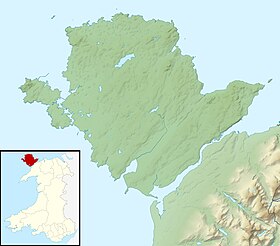Bryn Celli Ddu

Bryn Celli Ddu, northeast entrance
|
|
| Location | Southern Anglesey, 1km from the Menai Strait (OS Grid ref SH507701) |
|---|---|
| Region | North Wales |
| Coordinates | 53°12′28″N 4°14′10″W / 53.2077°N 4.2361°WCoordinates: 53°12′28″N 4°14′10″W / 53.2077°N 4.2361°W |
| Type | Chambered tomb |
| History | |
| Periods | Neolithic |
| Site notes | |
| Excavation dates | 1928-29 |
| Archaeologists | W J Hemp |
| Condition | Excellent |
| Public access | Yes |
| Website | cadw.wales.gov.uk |
| Reference no. | AN002 |
Bryn Celli Ddu is a prehistoric site on the Welsh island of Anglesey located near Llanddaniel Fab. Its name means 'the mound in the dark grove'. It was archaeologically excavated between 1928 and 1929. Visitors can get inside the mound through a stone passage to the burial chamber, and it is the centrepiece of a major Neolithic Scheduled Monument in the care of Cadw. The presence of a mysterious pillar within the burial chamber, the reproduction of the 'Pattern Stone', carved with sinuous serpentine designs, and the fact that the site was once a henge with a stone circle, and may have been used to plot the date of the summer solstice have all attracted much interest.
Bryn Celli Ddu is generally considered to be one of the finest passage tombs in Wales. Unlike many stone chambered tombs, this not only has a complete passage and burial chamber, but is also buried under a mound or cairn, although this was re-instated following its excavation in 1929. As it now stands, the passage is 8.4 metres (28 ft) long, the first 3.4 metres (11 ft) being unroofed with a pair of portal stones. The main passage runs between vertical slab rocked walls roofed by a series of stone lintels. The mound, being substantially smaller than as originally made, no longer completely encloses the burial chamber, so the back wall is open to the air, allowing some natural light in.
Several unusual stones are at the site. Free-standing inside the burial chamber is a smooth stone pillar, some 2 m (6.6 ft) high, with a very rounded shape. Shaped stones of this sort are very rare. Rupert Soskin and Michael Bott recently suggested that it could be the petrified remains of a tree trunk, but Soskin later reported that the pillar has been identified as the metamorphic rock blueschist, not a fossil.
Beyond the back wall of the chamber, in a location that would once have been within the mound, is a replica of the 'Pattern Stone'. This was found buried under the mound, and has been put standing up in what is thought to have been its original location at a time when the site was a henge rather than a tomb. The patterns take the form of sinuous serpentine shapes that wind around both sides of the stone. Inside the tomb another stone has a small spiral pattern chipped into it, although its authenticity has been questioned.
...
Wikipedia

